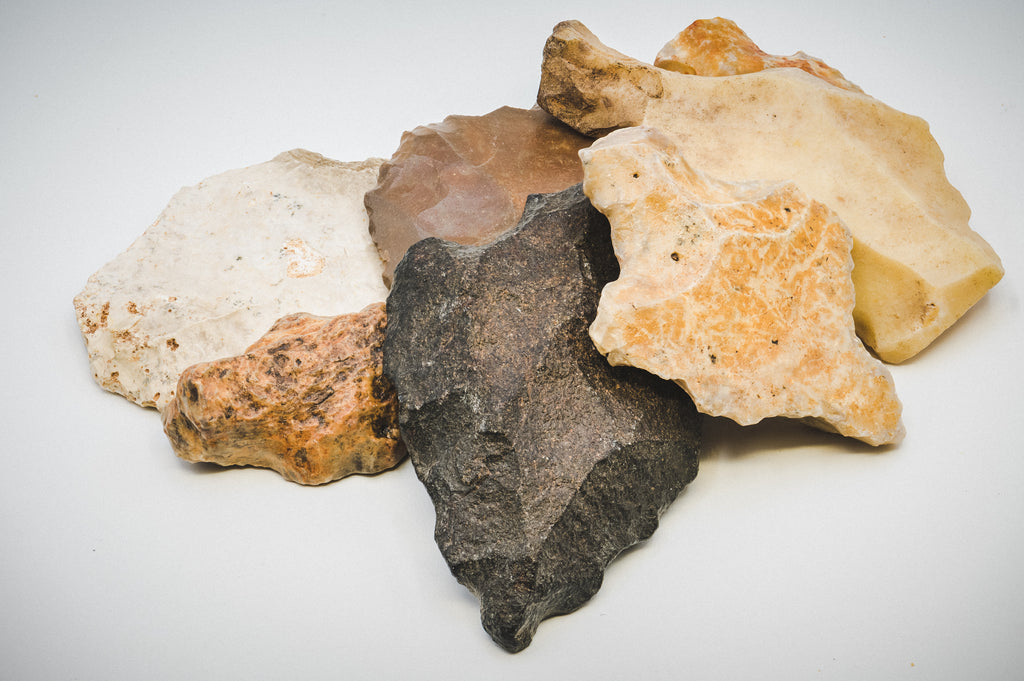Aterian Tools







Aterian Tools





























Above: Front of the Specimen Card
Tool making is a defining component in the evolution of human culture and sets us apart from the other creatures on the planet. Early in human history, in the middle of the Paleolithic, a new technological culture developed in North Africa: the Aterians. This group is known today for its advanced techniques and the differentiation of their tools. By studying what the Aterians left behind, we can learn much about how they lived.

Above: A selection of Aterian Tools. Note that sizes, shapes, and colors will vary.
This specimen is a complete Aterian tool as found in North Africa.
Each individual tool is presented inside a classic, glass-topped riker display case measuring 4 1/2" x 3 1/2". A small information card is also enclosed that also serves as the certificate of authenticity.
Please Note: Color, size, and shape varies widely based on each individual stone. As might be expected with stone tools that are many thousands of years old, the condition will also vary as most have been worn over time.

About Aterian Tools and Culture
"A paleolithic group collectively or individually endowed intellectually beyond its contemporaries," ~ Gertrude Caton Thompson

Above: Rock paintings in Tadrart Acacus region of Libya dated from 12,000 BC to 100 AD. There are paintings and carvings of animals such as giraffes and elephants reflecting the dramatic climatic changes in the area. (Source: Luca Galuzzi)
The first tools classified as part of the Aterian culture were found at the Bir el Ater site in Morocco. These stone tools date back as far as 150,000 years old, near the beginning of the last interglacial period. They are most commonly defined by their leaf shape, bifacial workings, and the tang or stem at the back of the tool.
Since any organic material that was a part of the tools like wood or sinew would have decayed over time, we can only study the stone portions of the tools. The tanged stems found on the stones tell us that they were hafted into wooden rods, an advanced technique for the time. The tang is inserted into a handle, giving the tool more leverage and reach. Hafting allowed for larger and more complex tools, as one could have the strength of a stone edge with a handle made of simpler material. This technique could have been used to create spears or even early arrows.
Although some of the Aterian tools were used as weaponry, researchers believe that many were actually scraping and cutting tools for preparing hides, plants, and meat. Some of the more rounded edge tools fall into this category and analysis of these tools show evidence of frequent sharpening and reshaping by the Aterians. This constant upkeep is seen most often in tools that were used for routine tasks, like knives, choppers, and scrapers.
It’s thought that the Aterians gathered resources from a wide variety of sources, drawing on the sea as much as hunting and foraging. For each activity they had different tools and techniques. This differentiation is early evidence of a modern way of human thought, swapping out methods for each situation to improve efficiency. It’s possible that this behavior gave the Aterians an edge over their Neanderthal neighbors in Eurasia. The Aterian stone culture disappeared around 20,000 years ago, but not before expanding beyond North Africa and possibly across the Mediterranean.
Further Reading
Garcea, Elena A. A., editor. “The Spread of Aterian Peoples in North Africa.” South-Eastern Mediterranean Peoples Between 130,000 and 10,000 Years Ago, by Nick Barton et al., Oxbow Books, Oxford; Oakville, 2010, pp. 37–53.
Iovita, Radu. “Shape Variation in Aterian Tanged Tools and the Origins of Projectile Technology: A Morphometric Perspective on Stone Tool Function.” PLoS ONE, vol. 6, no. 12, 2011, doi:10.1371/journal.pone.0029029.
 Above: Back of the Specimen Card
Above: Back of the Specimen Card










